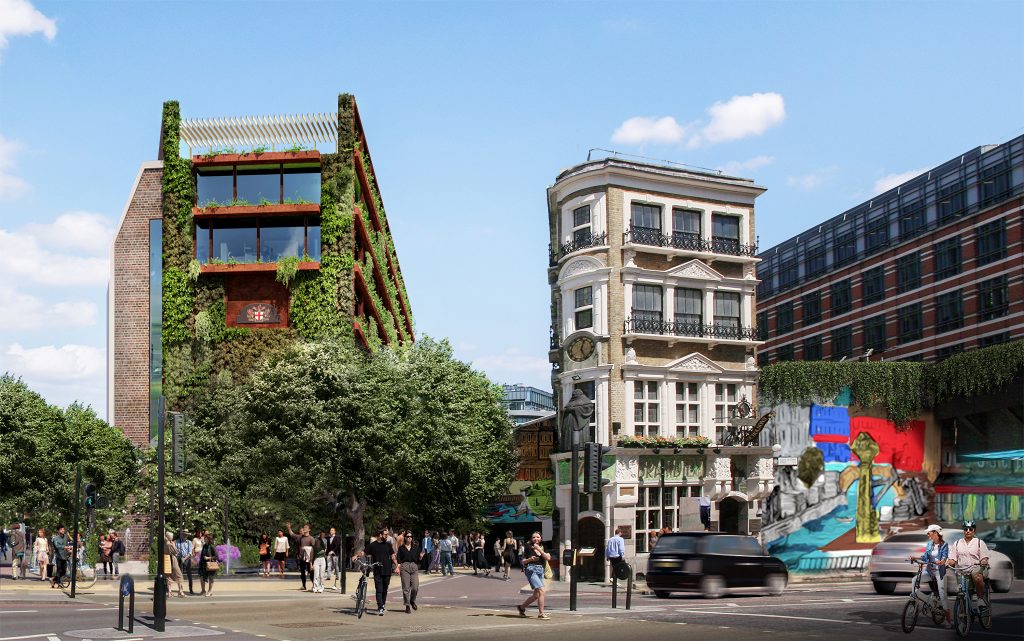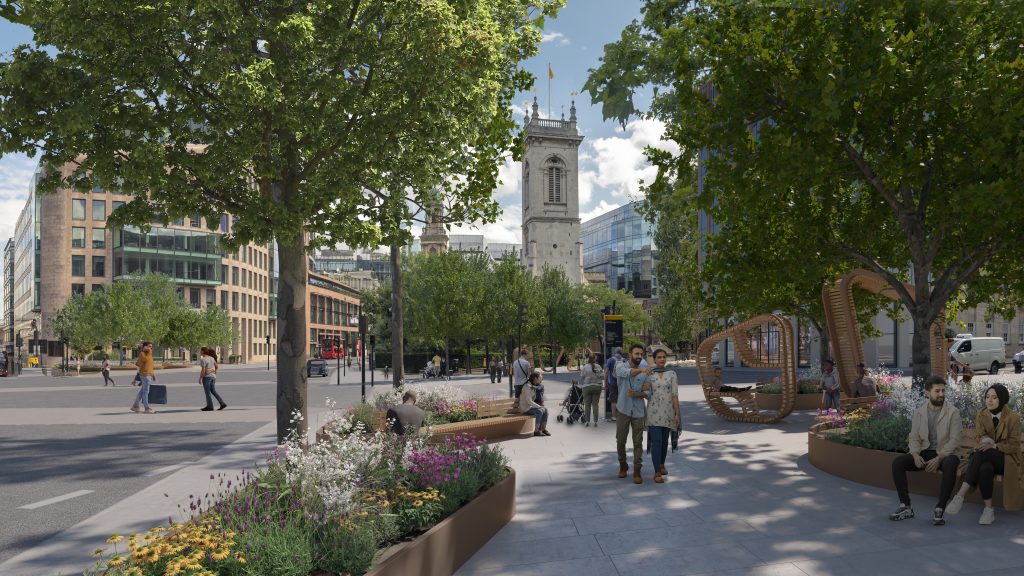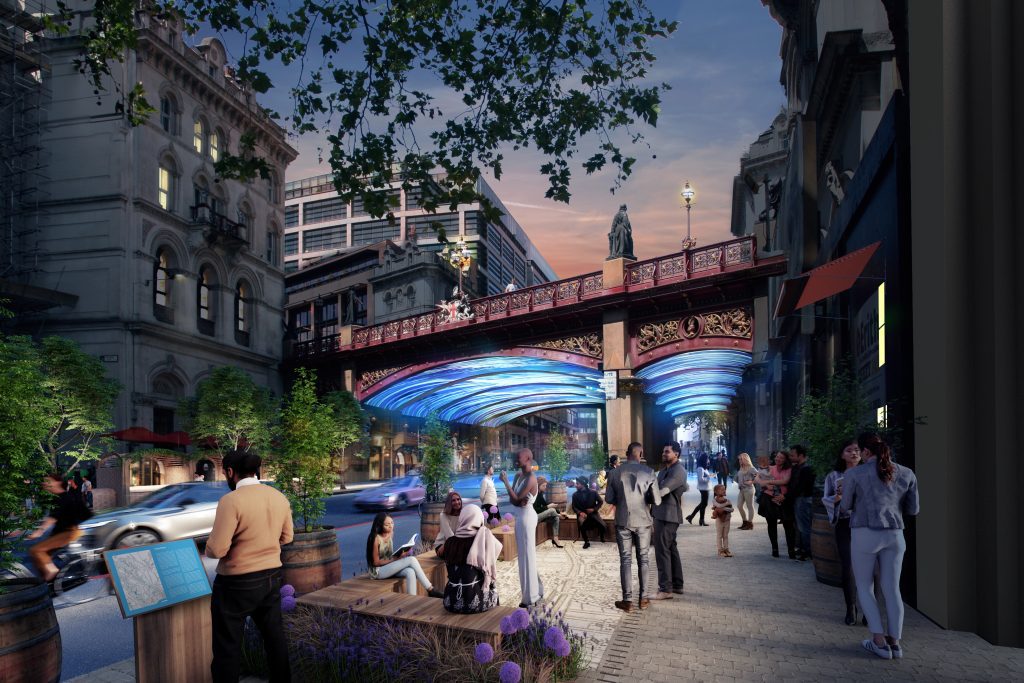FLEET STREET QUARTER’S ERA OF CHANGE
- The Fleet Street Quarter BID is spearheading a proposed new public realm masterplan, set to enhance the 3.25 million sq ft development pipeline
- Identifies 34 new public realm opportunities across this 43 hectare area of the city
- The proposed public realm aspirations will help the area welcome an additional 25,000 office workers who are set to be attracted to this western part of the city by the £5 billion pipeline of 34 new and refurbished office, retail and leisure schemes
- Responding to demand from businesses across the area, the proposed vision showcases 100% increase in safe cycle routes and 3,000sqm of additional pedestrian space
- Major reinvention project will put Fleet Street Quarter area back on the map
A radical new place-making and public realm vision has today been revealed by the Fleet Street Quarter BID, representing over 350 businesses across a 43 hectare footprint of the western part of the City. The proposed strategy could be the biggest transformation that this part of the City has seen since Bazalgette Embankment 150 years ago.
This estimated £80 million strategic vision could see the public realm transform over the next decade to meet increasing demands from businesses, occupiers, residents, and visitors. An investment which would mirror the area’s extensive development pipeline totalling £5 billion, which includes ground-breaking schemes including the City of London’s new Justice Quarter at Salisbury Square.
The proposed vision seeks to maximise the potential for Fleet Street in line with the area’s new designation in the City of London’s ‘Local Plan’ as a Key Area of Change.
For 2000 years, the Fleet Street Quarter area has shown an extraordinary capacity for re-invention, with this next period of evolution set to be the most radical yet. The proposed 10 year public realm vision identifies 34 public realm opportunities that could be seen across the 43 hectare area.
The Fleet Street Quarter BID commissioned global architecture, design, and planning firm Gensler, Norman Rourke Pryme and UP Projects to develop this new vision for the area, in consultation with the City of London and other key stakeholders and businesses.
The strategy titled ‘Fleet Street Quarter’s Era of Change’, was launched today at an event to over 100 business and stakeholders from across the Fleet Street Quarter area.
A key commitment in its BID Proposal, the proposed vision aims to deliver an attractive and sustainable community for workers, visitors and residents, supporting local business growth in the area over the next ten years.
The 34 identified opportunities will result in improvements to reconnect the area, enhance movement and walkability, address issues of legibility, and provide green spaces and amenities for people to enjoy. The ambitious vision targets a more unified and improved experience for the Fleet Street Quarter area.
The Fleet Street Quarter Era of Change vision highlights the following improvements:
- The creation of 3,000 sq m in additional pedestrian space
- 100% increase in plants, insect and bird species
- 100% increase in safe cycling routes
- 75% increase in seating space for residents and visitors
- 50% increase in more workers returning to the office
- 50% increase in footfall to historic and cultural destinations
- 50% increase in ground floor planting
- 25% increase of public realm usage in hours per day (evenings and weekends)
- 25% increase in trees planted in the area
The proposed public realm vision is intended to support the re-positioning of the Fleet Street Quarter area as a key contributor to the City of London’s economy. Green shoots are already emerging in the Fleet Street Quarter area, as it looks to develop its support of the local economy. Since 2018, the total number of jobs in the area has grown by 5.9%, with GVA per worker increasing by 13% in the same period.
The Fleet Street Quarter Era of Change Strategy targets an improved experience for retail and leisure, discovery and work, a blend identified by Gensler’s recent City Pulse Index Findings as criteria for a great Central Business District (CBD) experience.
The proposed widening of the pavements on Fleet Street and the Holborn Forest scheme would improve the streetscape and offer green spaces where residents and visitors can relax in nature – both key physical improvements desired by respondents in the City Pulse Index Findings.
This ambition to re-invigorate this area and transform it into a thriving retail and leisure destination is further amplified in the City of London’s City Plan, where it highlights the need for the creation of more distinct retail and leisure mix, using heritage assets, meanwhile uses and development opportunities to enliven the area and create more continuous active frontages.
The first design ideas were revealed today and are subject to further development and consultation with City of London Corporation, Transport for London and key stakeholders and businesses in the area.
Key locations for hero opportunities:
Fleet Street – Major transformation project to widen the pedestrian footpath, plant new trees and introduce new greening and seating.
Holborn Circus – Creating an urban forest and increased public accessibility. Providing pop-up facilities and introducing art installations. Increase the variety of seating areas for workers, visitors and local residents to enjoy.
Holborn Viaduct – Creating a new gateway to the area from Farringdon Station and the new Museum of London with the creation of art installations and an infographic that celebrates the history of the Fleet River.
Ludgate Circus – Improving pedestrian accessibility across Ludgate Circus through the introduction of a diagonal crossing and widened footpaths. Enhancement to pedestrian experience by creating new seating, planting new greenery and improve wayfinding.
Blackfriars Gateway – Transforming the existing underpass and traffic islands to allow for additional planting, seating and introducing art installations to improve the gateway experience
Following the adoption by the Fleet Street Quarter BID and its members, the strategy will also be used to start discussions and facilitate decision making with stakeholders in the area including City of London, Transport for London, developers, businesses, residents, institutions, and community groups.
Improved public realm will support the local economy by creating opportunities for events, markets and cultural activities, drawing visitors to the area. The activation of the Fleet Street Quarter area’s alleys, squares and public spaces is already underway. Through an activated programme of seasonal marketing campaigns including an area wide lighting scheme for Christmas due to launch this year to animate the spaces and attract new audiences to the area.
The overall mission of the ‘Fleet Street Quarter Era of Change’ strategy is to develop a vision and framework to support the development pipeline over the next decade To drive further growth in the area the City of London in its new ‘Local Plan’ identifies the area as a Key Area of Change and the Fleet Valley as an area for tall buildings.
The report runs alongside the City of London’s draft Fleet Street Healthy Streets Plan, which maps out an integrated approach to improving the public realm and managing traffic and to support the delivery of the City of London’s new Transport Strategy outcomes in the area.
In collaboration with VuCity, the Fleet Street Quarter BID also unveiled 3D modelling showcasing how buildings, street furniture and roads could develop under the strategic plan. Using an interactive game engine platform, VuCity have developed highly accurate and cutting-edge 3D modelling that shows the potential process of change in the area. A window into the future of town planning, VuCity’s digital modelling is the first of its kind in London and allows the Fleet Street Quarter BID to visualise opportunities for development to key stakeholders.
Lady Lucy French OBE, Chief Executive of the Fleet Street Quarter BID comments: “This project is a once-in-a-generation opportunity that calls for a joint collaborative approach to the ongoing improvements of the streetscape and public spaces. The sheer scale of this transformation is directly what we know our businesses and investors in the area want to see, it is a direct response to the voices of our levy payers and the wider community. This area is steeped with a rich history but now it is about taking it forward into its next phase of transformation, ensuring the area is globally competitive and catering for a new generation of visitors, workers and businesses.’
Deputy Shravan Joshi MBE, Planning and Transportation Chairman, City of London Corporation, comments: “As footfall across Central London continues to rise, it is crucial the City Corporation supports organisations like the Fleet Street Quarter BID to make the Square Mile a safer, more inviting environment for everyone. The new City Plan has designated the Fleet Street Quarter as an area to encourage new development, in order to deliver greater inward investment and economic growth.
With the launch of the Fleet Street Quarter’s public realm strategy, as well as the changes being made, in tandem, to our own City Plan and Transport Strategy, the Square Mile will become an even more desirable and inclusive seven-day-a-week visitor destination, for all to enjoy.”
Ian Mulcahey, Director of Cities at Gensler, said: Ian Mulcahey, Global Director of Cities, Gensler, said: “We are delighted to be developing the strategy for one of the biggest improvement initiatives in the City of London in over 100 years. The reinvigoration of the Fleet Street Quarter has the potential to transform an essential and historic part of London’s Central Business District to create a dynamic 24/7 working, cultural and visitor destination.”





Building, Design & Construction Magazine | The Choice of Industry Professionals





